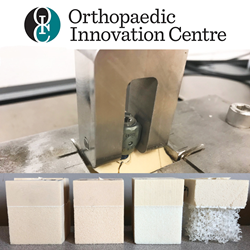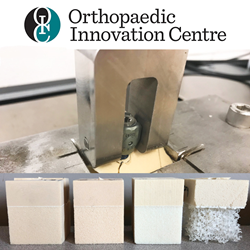
Orthopaedic Innovation Centre looks at ways to improve the outcome of spinal fusion using pedicle screw fixation
The research discussed in the article investigates implant fixation in various bone qualities, purchase depths, and implant designs through artificial bone modelling.
WINNIPEG, Manitoba (PRWEB)
December 11, 2019
The Orthopaedic Innovation Centre Inc. (“OIC” or “the Company), a non-profit centre for medical device testing and research and development, announced today the release of a featured article in Spinal Surgery News detailing implant fixation in lumbar spinal fusion.
Spinal fusion is indicated as a surgical remedy for degenerative and infectious diseases, trauma, and deformities of the spine by immobilization of the affected area using screws and rods. Despite surgical intervention, a number of fusion procedures fail as a result of implant loosening.
The research discussed in the article investigates implant fixation in various bone qualities, purchase depths, and implant designs through artificial bone modelling. Additionally, the effect of screw loosening on fixation was tested through simulated loading conditions. OIC has been collaborating with the orthopaedic surgeons specializing in spine at the Health Sciences Centre in Winnipeg, MB on this study, among several other research topics.
The article describes how these factors impact implant fixation and what cases would present a higher risk of implant loosening and fusion failure. The main findings in this article are:
-
Implant fixation of screws with a conical fine pitch design had the highest fixation in most bone qualities and all purchase depths in comparison to the other designs tested. On the other hand, cylindrical screws with coarse thread pitch showed the lowest form of fixation. - Screw fixation improved with bone quality.
- Reduced purchase depths showed a significant loss in fixation when conditioned by simulated loading, and a negligible loss without simulated loading.
- Fixation was decreased as a result of simulated loading conditions applied to osteoporotic bone.
The article discusses the importance of these findings, as they affect the success of lumbar spinal fusions. Continued research is underway to investigate how cement augmentation can change screw fixation, specifically in cases of severe osteoporosis. Furthermore, the OIC is studying similar factors on implant fixation in cervical spine.
You can read the article online here: https://www.spinalsurgerynews.com/2019/12/improving-pedicle-screw-fixation-in-lumbar-spinal-fusion/44914
About the Orthopaedic Innovation Centre:
Backed by engineering expertise, experience, and a passion for research and innovation, the Orthopaedic Innovation Centre excels in supporting the medical device industry through static and dynamic mechanical testing, precision measurement, clinical research services, and product development activities. The OIC is ISO 9001:2015 certified and headquartered in Winnipeg, Manitoba, Canada.
Share article on social media or email:

